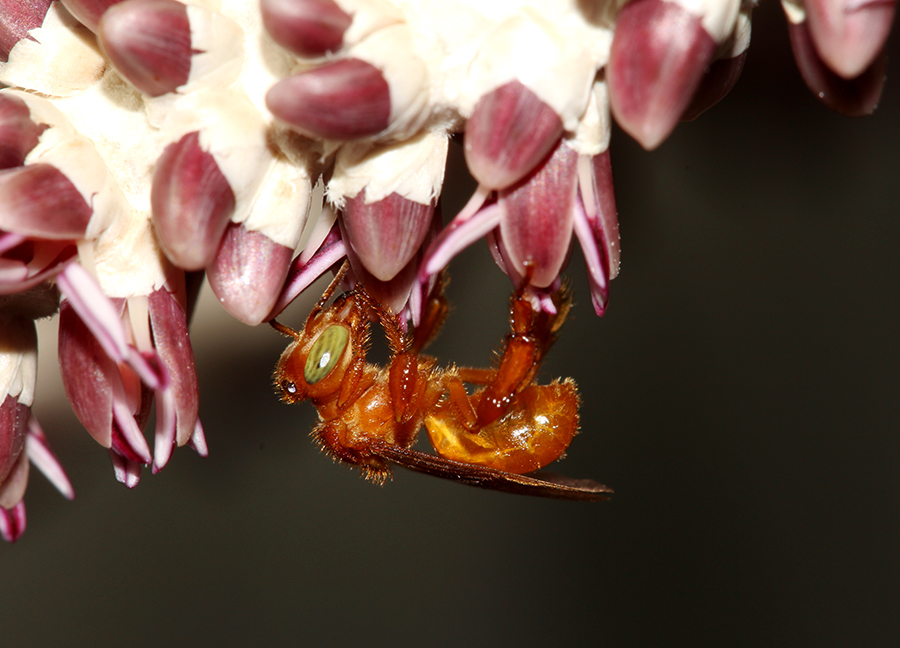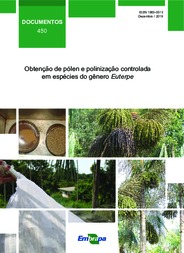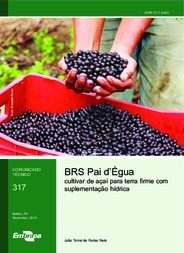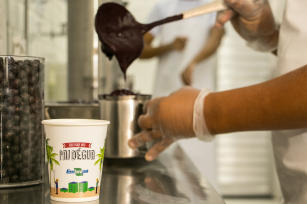More than 90% of açaí pollination is carried out by bees from the Amazon
More than 90% of açaí pollination is carried out by bees from the Amazon
Photo: Cristiano Menezes

A equipe de pesquisa, ao estudar o número de grãos de pólen de açaí transportados pelos insetos, descobriu que as abelhas nativas são o grupo de polinizadores mais eficaz
|
Native bees are the main pollinators of açaí (Euterpe oleracea). This is what a study that has just been published in the scientific journal Neotropical Entomology, by Embrapa, in partnership with the Federal University of Pará (UFPA) and the Federal Rural University of the Amazon States (UFRA). The work shows that they represent more than 90% of the pollination work on the flowers of the palm and are more efficient in the transport of pollen than the other insects, which directly impacts the production chain of açaí
The study was carried out in eight areas in the municipalities of Barcarena and Abaetetuba in Pará. Four managed areas of açaí de várzea and another four plantations on dry land were analyzed. At the sites, insects of 74 different species were collected that visited the flowers of the palm.
Lead author of the article, UFRA agronomist Leilane Bezerra says that when studying the number of açaí pollen grains carried by insects, the team found that native bees are the most effective group of pollinators.
Eight times more pollen
“We found that more than 70 species of insects, including bees, flies, wasps, ants and beetles, carry açaí pollen. But native bees, including stingless (Meliponinae) and solitary species (such as those of the Halictidae family), carry at least eight times more pollen than other insects and represent six out of ten insect visits to açaí flowers,” she reveals.
According to biologist Márcia Maués, a researcher at Embrapa Eastern Amazon, co-author of the work, until now scientists have known little about the percentage of contributions from different groups of insects to the pollination of açaí. This knowledge, according to her, is fundamental to support recommendations to farmers about pollination and pollinator management of this palm so important for the economy of Pará and Brazil.
“Pollination is an essential process for the production of seeds and fruits in three quarters of the global crops. But for many tropical crops like açaí, knowledge about pollination was still limited, making it difficult to develop friendly agricultural practices for pollinators”, the scientist comments.
| A R$3 bi market in Pará Açaí palm (Euterpe oleracea) is native to the lowland areas of the Amazon, but its planting on dry land has been conquering the market. In 2018, the state of Pará produced 1.4 million tons of the fruit, in an area of almost 200 thousand hectares, according to the Brazilian Institute of Geography and Statistics (IBGE). This total involves the management of lowland areas and land plantations. In the Pará economy alone, the product moved around three billion reais in 2018. |
Floral visitors
The survey analyzed all visitors to the palm tree during the female phase, whose period is four to eight days, in the period of greatest flowering of the palm, between March and June. This, according to Maués, served to facilitate the identification of potential pollinators, “since only insects that transfer pollen to female flowers can pollinate”, he details.
She explains that açaí is a species that depends on cross-pollination between male and female flowers on different palm trees. When searching for food, insects carry pollen from male to female flowers and it is in the latter that pollination occurs. “All are visiting insects, but some are collectors and others are pollinators. Our study focused on the second group ”, he adds.
The first result found by the scientists was that more than half (51%) of the 596 visiting insects collected on the palm are native bees. Stingless bees account for 38%; flies are 16%; other bees (solitary and mostly native) account for 13%; wasps, 12%; ants, 8%; and 6% are beetles.
The next step was to quantify the pollen grains present in the body of each insect, which the research calls the pollen load. This activity revealed an average of two grains per animal, as in 25% of them pollen was not detected. “However, we found solitary bees that carried up to five thousand pollen grains in their bodies. It was as if it had been dipped in flour”, compares biologist Alistair Campbell, a visiting researcher working at Embrapa Eastern Amazon.
The study proved that native bees represent more than 90% of açaí pollination, which includes stingless (60%) and solitary (35%) bees. Out of the four native species that stood out in the pollen load and abundance in the flowers, two are solitary bees of the genera Augochloropsis and Dialictus; and two other stingless species of the genus Trigona, the arapuá (Trigona branneri Cockerell) and the glass eye (Trigona pallens Fabricius).
The stingless bees also had advantages over solitary bees, as Campbell says. “They visit flowers more frequently, almost always carry pollen and have more populous colonies.
Such species are more consistent in the pollination of açaí and can be created and managed ”, he details. The calculation made by the scientists considered pollen load and the frequency of visits.
Nothing replaces the forest
Campbell also explains that there is little knowledge about the management of solitary bees and that many of them build their nests on the ground. In the case of Trigona bees, handling is also not easy, because, despite having no sting, they are aggressive and require more care.
However, there are other meliponines that can be managed. The scientist says that maintaining the forest around plantations, contributing to natural pollination, is still the best option for the producer.
Inserting hives in areas of açaí planted on dry land and in managed lowland areas is a strategy to increase fruit production, especially when there is deforestation in the surroundings, according to Campbell. However, there is no substitute for preserving the forest in maintaining biodiversity. “We will never be able to reproduce the effort of the forest”, says the scientist.
“The results show that açaí production depends on a diverse set of bees to obtain high harvests. Some of them can be managed in hives. But it is important that producers maintain preserved forests close to the production areas to promote wild pollinators and high fruit production ”, reinforces biologist Cristiano Menezes, from Embrapa Environment, co-author of the work.
He also says that producers can invest in managed pollinators. However, this involves costs of purchasing hives and maintaining colonies. “Still, the wild pollinators present in the forest are more efficient. It is better to have smaller areas of açaí surrounded by forests that produce more fruit per clump than larger plantations that produce much less ”, concludes Menezes.
Açaí pollen under the microscope. Image by Marcia Motta Maués
High value service
The authors reinforce the need for more research on pollination of açaí to transform these discoveries into agricultural practices that protect biodiversity and human well-being. “The total value of animal pollination for Brazilian agriculture is estimated at R $ 43 billion per year. And in the tropics, 90% of flowering plants depend, at least partially, on pollinators to produce their fruits and seeds ”, says Maués.
To reach at the recent study, the team of researchers has been working since 2016. Maués says that there are nine projects that study bees and pollination, funded by the National Council for Scientific and Technological Development (CNPq) in partnership with the Brazilian Institute of the Environment and of Natural Resources (Ibama), Ministry of Science, Technology, Innovations and Communications (MCTIC) and Brazilian Association of Bee Studies (Abelha).
“This is the first call for proposals from CNPq with contributions from public-private partnerships. Among the objectives of the project is the study of the role of bees in the pollination of different fruit and tree species and the impact on the productivity of plantations and managed areas ”, says Maués, coordinator of the work.
Growers had more produtivity and higher pulp yield
That açaí is a good deal is nothing new. But handling stingless bees in plantations was the innovation that producer Fernando Miranda sought at Embrapa. He has a plantation of 12 hectares of açaí in the municipality of Santa Bárbara, in the Metropolitan Region of Belém (PA).
When Miranda started her production of açaí, she looked for techniques and actions that could increase the productivity of her area. “I became interested in the pollination carried out by stingless bees and, in December 2017, I conducted training at Embrapa on the creation and management of these insects”, he says.
He recalls that he had difficulty finding suppliers of colonies in specific boxes. “For this reason, I chose to carry out a work to identify the species that occurred naturally in my açaizal and maintain the preservation of the colonies”, he reports. That was how the farmer’s partnership with Embrapa was established. The institution’s technicians began to evaluate the Miranda area and carry out studies on the site, where a meliponary was installed.
“The results are, without a doubt, very encouraging”, celebrates the producer. He says that there was an increase in the amount of fruit production of approximately 30% when the plantation was exposed to the new colonies brought by Embrapa. In addition, palm trees started to produce fruits with better quality and better pulp yield.
Photo: Ronaldo Rosa
Translation: The Food Challenge
Ana Laura Lima (MTb 1268/PA)
Embrapa Eastern Amazon
Press inquiries
amazonia-oriental.imprensa@embrapa.br
Phone number: +55 91 3204-1200
Further information on the topic
Citizen Attention Service (SAC)
www.embrapa.br/contact-us/sac/



